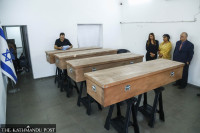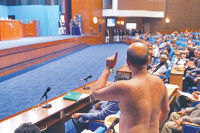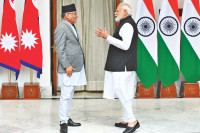Special Supplement
Everything you need to know about the reconstruction of Kasthamandap
After wrangling between local community members and the National Reconstruction Authority for three years, the rebuilding of Kasthamandap is finally underway.
Asmita Manandhar
The Metropolitan Police Range at Hanumandhoka is filled with wooden structures salvaged from the Kasthamandap, known locally as Maru Satta: after it fell during the 2015 earthquake. While the courtyard holds centuries-old relics in neat stacks, the walls inside the office of the Kasthamandap Reconstruction Committee, overlooking the artefacts, is plastered with maps and old photographs of the erstwhile pavilion-marketplace.
Ever since the 2015 earthquake brought Kasthamandap down, the reconstruction of the oldest and largest traditional building, built by lumber collected from a single tree according to legends, has been through several phases. Initially, a campaign led by local community members had stepped forward to rebuild the temple through public fundraising and voluntary labour contribution after a huge public outcry against a Department of Archaeology reconstruction plan that attempted to the use steel and concrete. But after lengthy political wrangling, the campaign is no longer steering the rebuilding process, instead a committee has now been formed, in coordination with the Kathmandu Metropolitan City (KMC), to rebuild Kasthamandap.
“We performed a chhyama puja (prayer for forgiveness) on May 14 to steer the rebuilding of the Kasthamandap and have since been working with high speed and spirit,” says Rajesh Shakya, chairperson of the Kasthamandap Rebuilding Committee (KRC) and also a Provincial Assembly member from the area.
This was not the first time the rebuilding of Kasthamandap was officially launched. The historical pavilion—a rest house for traders crossing the trans-Himalayan route that connected Tibet to India—holds immense cultural and symbolic importance. But instead of upholding the cultural value of this heritage site, KMC, a year after the earthquake, had prepared to invite bids for the temple’s reconstruction, a plan that was vehemently opposed by the local community. The ‘Campaign to Rebuild Kasthamandap’, a community-led initiative was then formed to oppose the contract-based building and the usage of steel and concrete in the reconstruction of the temple.
Shakya acknowledges that the campaign has led the way to the current development of the reconstruction process. “Had it been given under a contract basis, the temple wouldn’t have retained any of its essence,” he says, reiterating his commitment to using indigenous methods and preserving both tangible and intangible heritage.
For two years after the earthquake, the local community, joined by elderly and young supporters alike, secured the site and resisted any efforts from state entities to rebuild a structure that didn’t comply with the historical and cultural significance of the Kasthamandap.
But according to campaign leaders, the newly-formed committee has been sidelining all of the campaign’s efforts. Although the campaign was initially a loose group of like-minded individuals fighting for heritage conservation, on May 12, 2017, an agreement was signed between four parties—National Reconstruction Authority (NRA), Department of Archaeology (DoA), KMC and the campaign, now a registered organisation—to hand over responsibility of rebuilding Kasthamandap to the campaign.
“But mere six months after the agreement, the NRA urged us to let the KMC take over the reconstruction process, which we had denied at the time,” says Birendra Bhakta Shrestha, chairperson of the campaign., “We wanted to set an example by rebuilding national heritage through a community-led initiative by fundraising from the people and accepting voluntary labour contributions.”
When asked about the practical implications of such an ambitious plan, Yagyaman Pati Bajracharya, a Buddhism scholar and one of the leaders of the campaign, says that it is certainly possible. “We wanted to collect exactly Rs 100 from everyone in the Valley and had held talks with various community organisations for their labour contribution. We wanted to build community ownership by reconstructing the temple through direct community aid,” said Bajracharya.
The NRA did not comply with the agreement to hand over rebuilding authority, say campaign members. “But we didn’t go to court because we didn’t want any further delay in rebuilding Kasthamandap,” says Shrestha.
Shakya, on the other hand, says that the committee has incorporated the concerns of the campaign and has included campaigners on its co-committees. Both Shrestha and Bajracharya, however, refuse to attend meetings on the grounds that the campaign as a whole should be recognised, rather than individual appointments.
According to Shakya, his team searched for the timber and soil to replicate the primeval design and build. For the wooden structures, a August 12 Cabinet decision sanctioned the use of timber from various forests in Bardibas, Mahottari, Rautahat and Sarlahi districts. Soil ideal for reconstruction, which constitutes one-part clay, two-parts silt and three-parts sand, was discovered closer, at Tahachal in Kathmandu. Then, on the first day of Nepal Sambat 1139 (November 8, 2018) the committee performed a shuvarambha puja (commencement prayer) and began the rebuilding process.

The silver lining
On December 24, 2016, a joint excavation was carried out by DoA and Durham University, which postulated that the temple was built in the 7th century. In earlier estimates, Kasthamandap had been identified as a 12th century monument. The new findings further bolstered the argument of the campaign that reconstruction be carried out along traditional architectural lines. According to Bajracharya, the findings endorse the fact that the building was built in line with Vajrayana Buddhist philosophy.
“The restoration of such cultural heritages is not something to be rushed. Although there was a three-year deadlock due to various political reasons, the silver lining was that there was an ample time to research,” says Kai Weise, an architect and an active advocate of disaster risk management of cultural heritage sites. Weise has been involved with the campaign for rebuilding Kasthamandap since its inception and is also providing his expert input to the new committee.
The committee is now moving forward under the assumption that traditional architecture can withstand more stress than a concrete structure. But they have been relying on modern technology to verify this assumption. “The lifespan of concrete has been proved to be 100 years but our traditional architecture had been standing since the 7th century. This is not something to be ignored,” says Shakya.
Way ahead
Binita Magaiya, a conservation architect who was initially hired by the campaign and then re-hired by the committee, says that after much delay, the rebuilding process is now moving swiftly ahead. “The campaign and the committee both follow the same school of thought of preserving tangible and intangible heritages,” says Magaiya, who worked under the direct supervision of Bajracharya during her time with the Kasthamandap campaign. “But now with the new committee, there is authority and certainty.”
Even campaign leaders, although dissatisfied with the committee formation process, say that they are satisfied with the committee’s work so far. “Even though I refused to be a part of his official team, the chairperson himself comes to me for advice regarding the incorporation of intangible heritage for the rebuilding process. He is aware about the social and cultural implications of Kasthamandap,” says Bajracharya.
During the chhyama puja, Minister for Culture Tourism and Civil Aviation Rabindra Adhikari said that the reconstruction of Kasthamandap would be completed within the next three years. KMC also sanctioned a cheque for Rs 5 million to the committee for the reconstruction process, on July 13.
The committee has plans to install four foundation pillars by January 29 2019 and complete the first floor by June of next year. They are very hopeful that the construction process will be completed within the given timeframe. They have also committed to document the entire reconstruction process, down to the management of each layer of bricks. There are plans to publish quarterly budget reports on their website to emphasise the transparency of the overall process.
But Bajracharya is still cautious regarding the committee’s methods and its usage of funds. “I have asked the chairperson to install a hoarding board in front of the site so that the public has access to all the information. Not everyone can go to their website,” he asserts.
Ganapati Lal Shrestha—coordinator of the Heritage conservation campaign struggle committee at Kathmandu Durbar Square, who has been overseeing the court cases against the construction of the Maharjan complex, demolition of Bagh Durbar and advocating against the usage of concrete at Rani Pokhari—concurs with Bajracharya. “The state is sensitive towards the community’s sentiments regarding the reconstruction of Kasthamandap after the extensive campaign, but other heritages inside the Durbar Square area are still being reconstructed through the tender process,” he says, doubtful that local representatives have been able to understand the collective sentiments of the indigenous community.
“As a community, for now, we have put our trust in the committee that it will rebuild Kasthamandap honestly, but we are also vigilant of their work and will stand against any misconduct,” says Shrestha.




 13.12°C Kathmandu
13.12°C Kathmandu.jpg)








%20(1).jpg&w=300&height=200)

